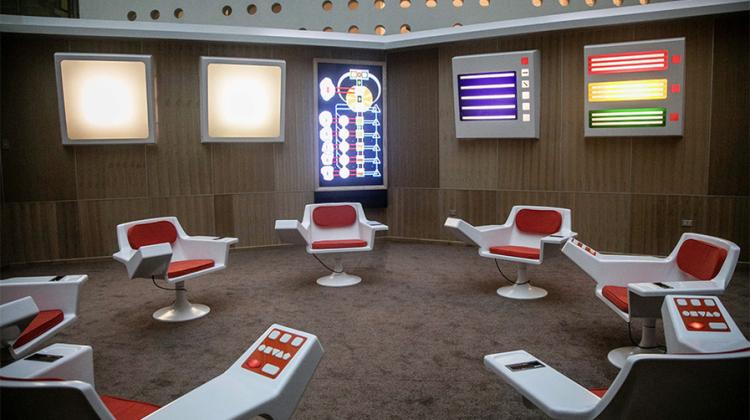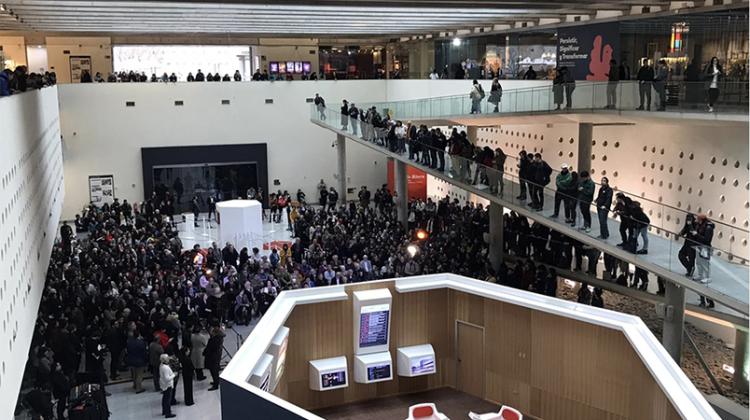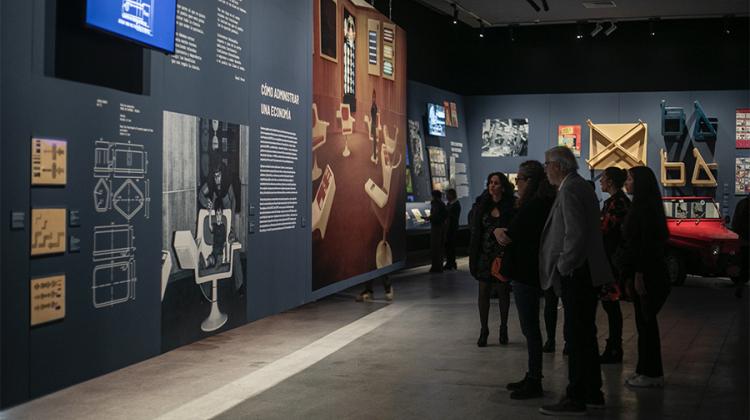Designing a Revolution

The full-scale reconstruction of the Cybersyn Operations Room is hexagonal and measures 72 square meters, with seven fiberglass armchairs equipped with buttons for remotely controlling screens on the room’s walls. Credits: Photo courtesy of Centro Cultural La Moneda.

The opening reception on Sept. 7 for “How to Design a Revolution: The Chilean Road to Design.” It’s the most extensive presentation of the history of graphic and industrial design during the Allende period. Credits: Photo: Rihn Hong

Attendees explore the exhibition at its opening reception on Sept. 7 at the Centro Cultural La Moneda. Credits: Photo courtesy of Centro Cultural La Moneda.
An MIT professor and students collaborate with Chilean partners for an exhibition marking 50 years since the Allende presidency.
Michael Brindley | School of Humanities, Arts, and Social Sciences
October 16, 2023
It is widely recognized that the period in the early 1970s in which Salvador Allende was president of Chile was a moment of political innovation, when people thought they could bring about socialist transformation peacefully and within existing democratic institutions.
“People thought that this would be a political third way,” says Eden Medina, an associate professor in MIT’s Program in Society, Technology, and Society.
Ultimately, a military coup brought a premature end to Chilean democracy and resulted in Allende’s death. But it’s a period of political and cultural history to which Medina has dedicated extensive research. As the culmination of that work, Medina is co-curating a museum exhibition, “How to Design a Revolution: The Chilean Road to Design” (in Spanish, “Cómo diseñar una revolución: La vía chilena al diseño”). The exhibition coincides with the 50th anniversary of the military coup. It’s the most extensive presentation of the history of graphic and industrial design during the Allende period.
“It has really been a collective effort to bring this history to the Chilean public and also to a larger international public,” says Medina.
The exhibition opened at the Centro Cultural La Moneda, the cultural center of the Chilean presidential palace, beginning last month. Medina is co-curating the exhibition with Professor Hugo Palmarola and Professor Pedro Ignacio Alonso of the Pontificia Universidad Católica de Chile. The exhibit will be accompanied by a book, which will be available in English and Spanish.
“The research we’ve been doing shows that this innovative political project opened the door to other kinds of innovation, including artistic innovation, and innovation in the areas of design, science, and technology,” says Medina.
Medina says the exhibition is bringing a new interpretation of the Popular Unity period and the practice of Chile’s political transformation. The exhibition features 350 pieces, including a full-scale reconstruction of the Cybersyn Operations Room, a pioneering project in cybernetics. The operations room was designed by the Industrial Design Area of the Chilean State Technology Institute between 1972 and 1973, and some of its original designers — Gui Bonsiepe, Fernando Shultz, Rodrigo Walker, and Pepa Foncea — collaborated in the reconstruction.
“By showing these designed projects, whether it’s the creation of a spoon to measure powdered milk or a poster to get people to volunteer their labor, we’re seeing what people did and how they were trying to figure out ways of bringing about socialist transformation,” says Medina. “The exhibition explores how those in the past looked to graphic and industrial design to create collective action, democratize knowledge and music, reduce technological dependency, improve child nutrition, and manage the economy.”
Regina Rodríguez Covarrubias, director of Centro Cultural La Moneda, says it’s the center’s most important exhibition of the year.
“Within the framework of the 50 years since the civil-military coup, this exhibition speaks to us from a little-explored place, beyond the trauma of the civil-military coup and the dictatorship: It allows us to know and appreciate an avant-garde Chile that used its creative resources to democratize culture, educate, and build bonds of coexistence in favor of equity and innovation,” says Rodríguez Covarrubias.
After three years of collaboration between MIT and the Pontificia Universidad Católica de Chile, Medina is excited to see what visitors experience when they step inside.
“When they go into the space of the Cybersyn Operations Room, they’ll see that the space isn't a fantasy, it was something that people built. It was futuristic, but it was also built under conditions of constraint. And you see how people were really creative when working under these conditions. They built something that was cutting edge using simple technologies. Even a low-tech space can be futuristic, and that is generative as we think about sustainable design today and the potential need to make better use of older technologies,” says Medina.
Student support
The project involved MIT graduate students from the Department of Architecture and undergraduate students from the Department of Mechanical Engineering. Medina says the project wouldn’t have been possible without the support of the students, which she says was an opportunity for them to collaborate with the MIT School of Humanities, Arts, and Social Sciences (SHASS) on a public-facing project in the humanities.
She adds the exhibition is an example of SHASS’s international reach, and how the humanities can collaborate with engineering and architecture to build historical objects and environments from a major historical moment.
“MIT provides a way of doing the humanities that I think is very unique. It allows students to take their technical training and their propensity to build and marry it with things like archival research and historical interpretation, and bring those skills together, in this case, for public communication,” says Medina.
MIT students working on the project say it’s been a transformative experience, one that uniquely combined their skills across disciplines.
Alissa Serfozo, MArch '26, a designer and master of architecture candidate at MIT, joined the project in autumn 2022 as a researcher and then editorial assistant for the exhibition edited volume. She conducted research on the posters designed during the time period that were ultimately recreated as artifacts in the exhibition.
“Our approach was to think critically about designed objects as political instruments. We considered the posters’ entire life cycle, from production to dissemination, observing the proximity of design and politics during this historical period,” she says. “Many of these posters live in private archives and are not often visible to the public. I’m thrilled to see the collection materialize in the final product of the exhibit.”
Serfozo says learning about the kinds of graphic design and printing used in that period inspired her to further her own expertise in the field.
“Throughout learning about the history of printing in 19th- and 20th-century Chile, I simultaneously became interested in that practice. I took cyanotype classes at the Student Art Association and did a self-study in silkscreen printing,” she says.
Azania Umoja, MArch '25, also a master’s student studying architecture, worked as editorial assistant for the project.
“For me, I'm very interested in work that redefines what architecture is and what it means to be an architect. Seeing the intersection between design and this important political movement in Chile's history was really fascinating to me,” Umoja says.
Rihn Hong '23 and Josh Noguera '23, who both graduated in the spring with bachelor’s degrees in mechanical engineering, worked on getting the logic and electronic recreation of the operations room functional. They spent time in Chile this summer putting the final touches on the exhibit. Noguera says one of his favorite parts of the project has been the intersection between historical research and technology.
“Working with the museum curators in Chile has been incredibly fulfilling in terms of getting experience, working with other people, and other teams,” says Noguera. “And now with recreating the system, a lot of interesting challenges that both Rihn and I have is the discussion of what should be omitted, or striking a balance between user experience in the exhibit and historical accuracy.”
Mariana González Medrano, MArch '23, completed her MIT master’s in architecture this spring, and was responsible for creating some of the early plans for the design of the operations room. It’s hexagonal and measures 72 square meters with seven fiberglass armchairs equipped with buttons for remotely controlling screens on the room’s walls.
One of the biggest challenges, she says, was the discrepancy she often found in the historical documents about what was planned and what was realized.
“And those discrepancies really lie in those small details of what angle do the walls curve in, exactly how high is the ceiling going to be, where does this thing exactly connect to the wall,” she says. “All these things end up having a large impact on the room. And every document carries its own story and vision of what the room is meant to do or convey in terms of how every single object and every detail relates to each other.”
Coming full circle
For Medina, the exhibit is the completion of years of work and research. Part of the work she’s doing to build and display this exhibit was part of her dissertation at MIT.
“If you had told my grad student-self that one day my dissertation research would be on display as part of a major historical anniversary in Chile, in the cultural center of the presidential palace, I just wouldn't have believed you,” she says. “It is such an opportunity to communicate history of technology research to a broad public and help them see the relationship of politics and technological design and to do it in a different kind of way. Not only to do it through a written text, which is how historians often work, but to actually build the space and invite members of the public to step inside. That's really special.”
Professor Hugo Palmarola considers this to be one of the most important cases of design in Latin America, since it is historically located at a fundamental turning point for development models in the region.
“The pieces selected for this exhibition were designed at the time to create new ways of life and a new political, social, and economic world. In this regard, we as curators think that these pieces configure a truly unprecedented project, which may have important implications in global debates and global studies of design, visual and material culture, technology, and curatorship,” he says.
Professor Pedro Ignacio Alonso says the making of the exhibition was not just a way to show results of a research project, but also a different way to keep learning about the history of the period, through its designed objects.
“It is, as it were, a different research format in the careful displaying of both original pieces from archives, and our reconstructions of objects that have disappeared long time ago, that now reemerge within our curatorial work,” he says.
After the exhibit closes in January, Medina says it is designed to travel, though there are no specific plans yet for where it might go.
Medina says her hope is the exhibit will bring to light the way people tackled some of the core challenges of society during this unique historical moment, so that it might inspire new ways of approaching similar challenges today.
“How do you improve education, nutrition? How do you raise the standard of living for the poorest members of society? How do you get people to participate politically? All of these questions are still relevant today. While the solutions people developed 50 years ago are not the same solutions that we need today, we can still learn from them and find inspiration in how design and technology in Chile foregrounded social, political, and human values,” says Medina.
Support for the project was provided by the MIT School of Humanities, Arts, and Social Sciences; MISTI; the Program in Science, Technology, and Society; the Pontificia Universidad Católica de Chile; the Centro Cultural La Moneda; the Chilean Ministry of Science, Technology, Knowledge, and Innovation; the Chilean Ministry of Culture, Arts, and Heritage; and the Goethe Institut Chile. MISTI Global Seed Funds supported the collaborative work for the exhibition in its early stages, and the MIT-Chile Program provided support for student travel.
Originally published October 16, 2023 by Michael Brindley, School of Humanities, Arts and Social Sciences for MIT News.


